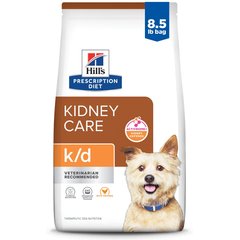High Blood Pressure in Dogs: Signs and How To Manage It

Photo by Robert Daly/iStock/Getty Images Plus
Your dog’s heart works every single day to keep blood pumping through their body and to keep every organ functioning. When that pressure rises above normal levels, however, it can put strain on the heart, kidneys, eyes, and other organs.
High blood pressure in dogs is often considered a “silent threat” that’s not obvious until serious complications arise.
Learn what high blood pressure is, common causes, signs to look for, and how to manage it.
Key Takeaways
- Hypertension in dogs is when there’s consistent, elevated pressure against the artery walls.
- Without management, canine high blood pressure can result in serious complications, such as blindness and congestive heart failure.
- High blood pressure in dogs is almost always secondary to other diseases, such as kidney disease and diabetes.
- Pet parents can take steps to monitor, manage, and prevent high blood pressure in canines.
What Is High Blood Pressure in Dogs?
Also referred to as hypertension, high blood pressure occurs when the force of blood (pressure) against the artery walls remains consistently higher than usual.
“In simplest terms, hypertension is primarily diagnosed by pressure in the arteries when the heart contracts. This is called systolic pressure,” explains Lisa Ciucci, DVM, veterinarian and owner of Gardens Animal Hospital in Palm Beach Gardens, Florida.
She explains that high blood pressure in dogs can damage blood vessels, deteriorate organs, and cause blindness, heart damage, or kidney damage.
Because only approximately 10% of dogs may experience hypertension, according to the American Kennel Club Canine Health Foundation, routine screening isn’t common. However, dogs diagnosed with chronic conditions often associated with hypertension—such as kidney disease or Cushing’s disease—should have their blood pressure monitored.
What Is Considered Normal Dog Blood Pressure?
In healthy adult dogs, systolic pressure has a wide range.
“Even though ‘normal’ is considered 120mmHg, it can generally go up to 180mmHg and still be fine due to excitement or stress in the dog,” Dr. Ciucci explains.
She adds that veterinarians put minimal emphasis on diastolic pressure.
See the chart below for normal systolic and diastolic readings for canines.
Normal Systolic and Diastolic Readings for Dogs
| Measurement Type | Normal Range | What It Means |
|---|---|---|
| Systolic (upper number) | 110–160 mmHg | Pressure when the heart contracts |
| Diastolic (lower number) | 60–100 mmHg | Pressure when the heart relaxes |
| Mean arterial pressure (MAP) | 85–120 mmHg | Average pressure in the arteries |
How To Check a Dog’s Blood Pressure
When checking a dog’s blood pressure, Dr. Ciucci says veterinarians use non-invasive devices, such as the Doppler probe or oscillometric device with a cuff that goes around the leg or tail base. This is painless, though it can be a bit tricky to get a good reading if the dog is moving around a lot.
Simply taking one blood pressure reading isn’t enough to diagnose high blood pressure.
“Veterinarians are typically able to diagnose high blood pressure in dogs by obtaining a pet’s complete medical history, performing a physical exam, and performing blood and urine testing,” explains Sarah M. Cavanaugh (Scruggs), DVM, MS, DACVIM, a veterinarian specializing in cardiology.
In some cases, additional testing (such as an ultrasound) is necessary.
How To Check Canine Blood Pressure at Home
In addition to having your dog’s blood pressure measured at the vet, you can use a dog blood pressure monitor at home.
“The two most accurate blood pressure monitors for at-home use are the petMAP and the SunTech, though they are pricey,” Dr. Ciucci says.
What Are the Symptoms of High Blood Pressure in Dogs?
Signs of high blood pressure in dogs are subtle. They may include:
- Gradual vision loss
- Dilated pupils
- Blood in the eyes
- Weakness or difficulty walking
- Nosebleeds
- Behavioral changes, such as confusion or restlessness
- Disorientation or other neurological changes
Dr. Ciucci stresses that hypertension is almost always secondary to other diseases.
That said, be on the lookout for signs related to the underlying condition. For example, dogs might experience increased thirst or urination with kidney disease, hair loss and a pot-bellied appearance with Cushing’s disease, or sudden vision changes with eye disorders.
How High Blood Pressure Progresses
When left untreated, high blood pressure can lead to congestive heart failure.
Dr. Cavanaugh says that as the left ventricle works harder to pump blood, the heart muscle can become stiff and lose function. Hypertension may also impair the mitral or aortic valves.
If these cardiac issues become severe, they can increase pressure in the heart and nearby veins, causing fluid to leak into surrounding tissues, such as the lungs.
Signs of congestive heart failure in dogs include:
- Rapid or difficult breathing
- Coughing
- Low energy
- Fainting
What Causes High Blood Pressure in Dogs?
Dr. Cavanaugh says high blood pressure in dogs occurs when a pet’s arteries are too narrow or too “stiff,” making it so that the heart muscle has to work harder.
Common causes of high blood pressure in dogs include:
- Kidney disease
- Cushing’s disease
- Diabetes mellitus
- Hyperthyroidism
Other organs commonly affected by systemic hypertension are the eyes, kidneys, and brain.
Lastly, Dr. Ciucci notes that the following breeds may be more prone to developing high blood pressure:
How To Treat High Blood Pressure in Dogs
Specific treatments can significantly help regulate high blood pressure and improve a pet’s quality of life. Such treatments include daily oral medication, such as Amlodipine (a calcium channel blocker) and ACE inhibitors such as Enalapril, which can help dilate the arteries. Most pets tolerate these medications well and experience minimal adverse side effects.
Further treatment would include treating the underlying diseases. Reducing high blood pressure is the goal. Remember, “if you don’t treat hypertension in your dog, you can risk them getting irreversible damage to their eyes, kidneys, heart, and brain,” says Dr. Cavanaugh.
It’s also important to have your pet’s blood pressure checked regularly.
“Older pets are more likely than younger animals to develop high blood pressure, so senior [pets] may require testing on an annual or semi-annual basis,” says Dr. Cavanaugh.
How Can I Help Manage My Dog’s High Blood Pressure at Home?
It’s crucial to manage your dog’s hypertension to prevent or slow it from progressing into a more serious issue. Here’s how you can help.
1. See Your Vet Routinely
In the same way humans see a doctor regularly to manage and treat conditions, dogs—especially senior dogs—should routinely go to the vet.
2. Be Consistent With Medications
If your dog is diagnosed with hypertension and/or another disease that can cause high blood pressure, remain consistent with their medications. Keep their medications on hand and administer them as recommended by your vet.
When you’re away, ensure your pet sitter remains consistent as well. Pill pockets, like Pill Buddy Naturals, are one of many helpful tools to give dogs pills.
Recommended Product
3. Feed Them a Healthy Diet
“Veterinarians and nutritionists are currently investigating the potential link between nutrition and the development of chronic diseases, including heart disease in dogs,” says Dr. Cavanaugh.
Aim for a nutritionally balanced diet with minimal fillers and reduced sodium levels, such as Blackwood Complete & Balanced Diet.
Recommended Product
And if your pet has a specific diagnosis—such as kidney disease or diabetes—work with your vet to choose the appropriate food. For example, Hill’s Prescription Diet k/d Kidney Care can help with kidney issues.
Recommended Product
4. Exercise as Recommended
Make sure your pup gets enough mental and physical exercise each day. Regular stimulation greatly improves their quality of life and can help manage heart issues.
Consult with your veterinarian to determine what’s best for your pup, taking into account their age, mobility, and any existing health conditions.
5. Monitor Blood Pressure at Home
If you have a blood pressure monitor at home, you can take a reading every few days to once a week, depending on your dog’s stability and the underlying condition.
For the most accurate results, have your dog lie or sit calmly in a quiet space. Use the correct cuff size for their limb or tail, and take multiple readings, discarding any obvious outliers before averaging the numbers.
FAQs About High Blood Pressure in Dogs
Can dogs get high blood pressure?
Yes, dogs can get high blood pressure. Hypertension is typically a secondary diagnosis resulting from another underlying health issue, such as kidney disease or diabetes.
Can high blood pressure in dogs lead to blindness?
Yes, canine hypertension can damage the delicate blood vessels in the eyes, leading to retinal detachment or bleeding inside the eye. Eye damage happens because elevated blood pressure puts excessive force on the small, fragile vessels in the retina.
How long do dogs live with high blood pressure?
The lifespan of a dog with high blood pressure depends on how early it’s diagnosed, how well the underlying cause is managed, and whether complications have occurred. With prompt treatment and regular monitoring, many dogs can live for years with a good quality of life.
Can I check my dog’s blood pressure at home?
Yes, there are a few devices, such as the petMAP and the SunTech, that allow you to monitor your dog’s blood pressure at home. However, these can be pricey, and your veterinarian can likely get a more comprehensive reading and assessment. Additionally, it is crucial to treat both the symptoms and the underlying disease once hypertension is diagnosed.






